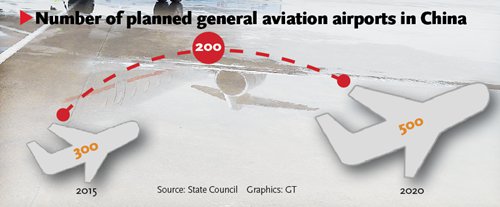Corporate jets gain altitude
Has spring come for China’s business aviation market?

Workers prepare on Monday for the Asian Business Aviation Conference & Exhibition 2017. Photo: CFP

Graphics: GT
This week's most exciting aviation news came out of Shanghai, where the annual Asian Business Aviation Conference & Exhibition kicked off at one of China's busiest airports.
For the last few years, the exhibition has been a chilly affair, but in 2017 more companies have shown confidence in the Chinese business aviation market.
Perhaps the days are growing warmer.
The business aviation show in Shanghai attracted a record of more than 170 exhibitors, which put 35 aircraft on display, according to data from the event's organizer.
Japan-based Honda Jet made its first appearance at the exhibition.
Ahead of the event's opening ceremony on Tuesday, Boeing said sales of its business jets have experienced unprecedented growth in China, where the number of Boeing business jets (BBJs) in operation has tripled over the last five years.
Boeing projected that the China's BBJ fleet will continue to expand in 2017. Two BBJs will go into service in 2017. Plus, the aircraft maker will deliver two BBJ MAX 8 airplanes to customers in China in 2018.
Airbus brought its ACJ319 business jet to the exhibition of 2017, marking the first time it put the 19-passenger aircraft on display.
Bombardier Inc, a major producer of business jets, said it has sold 280 business jets in Asia, including more than 110 in China, and it expects the number to keep rising.
Honeywell's customers in China have purchased 900 turbine helicopters and 450 business jets in 2016, with the compound annualized growth rates reaching about 6 percent and 9 percent, respectively, over the past decade. The company forecast it will deliver 3,900 to 4,400 civilian-use helicopters from 2017 to 2021, roughly 400 fewer than it predicted in its 2016 five-year forecast.
There are a number of countries and regions contributing more relative and absolute new helicopter purchase plans in the Asia-Pacific region, including China, Australia, South Korea, Japan and Malaysia, according to a Honeywell report.
The jets on display at the exhibition illustrate some of the changes that have taken place in the business jet world.
When the exhibition first opened in 2012, most of the aircraft on display were large-cabin, long-range business jets.
The show featured a wider range of jets in 2017, including some special-purpose aircraft, such as air ambulances.
China's business jet market has experienced two boom periods in recent memory. The first period was from 1995 to 2009, when China introduced one or two aircraft each year. The second period was from 2009 to 2013, when the country introduced aircraft overseas at a high rate of speed.
However, China's business aviation market is still in an early stage of development and has evolved differently than the market in the US.
The business aviation market in the US started with small, general aviation aircraft and grew to accommodate larger, long-range aircraft.
In China, business aviation began with the largest aircraft, before expanding to include smaller and lighter aircraft.
In addition, there are still some barriers to development going forward.
The country still lacks enough business airports, forcing business jets to compete with the commercial aircraft for air space, as well as arrival and departure slots.
Still, we can see that the government is determined to develop the industry. At the fair, an official from the Shanghai Airport Authority said the government is considering building a new business aviation airport to meet the rising demand for business jets in the metropolis.
In 2016, the State Council released guidelines that said China will add about 200 new general aviation airports by 2020, bringing the nationwide total to more than 500, making transportation between cities even more convenient.
The central government also hopes to have more than 5,000 general aviation aircraft and 7,000 pilots by the end of this decade.

